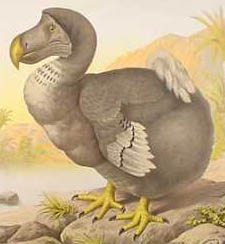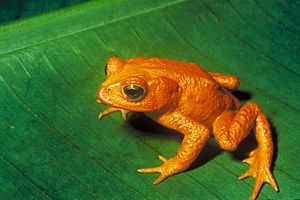Extinction facts for kids
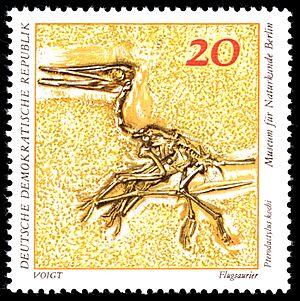
Quick facts for kids Conservation status
|
|
|---|---|
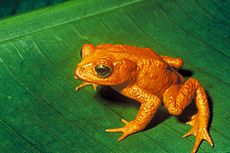 |
|
| Extinct | |
|
|
| Threatened | |
|
|
| Lower Risk | |
|
|
|
Other categories |
|
|
|
|
Related topics
|
|
 Comparison of Red list classes above and NatureServe status below  |
|
Extinction is a natural part of evolution, which is how life on Earth changes over time. A species is extinct when there are no living members left anywhere in the world.
Every species eventually faces extinction. This can happen for many reasons, like losing their habitat (their natural home), being overhunted, or during a huge extinction event that affects many species at once. For example, the Dodo bird became extinct because people hunted too many of them. Sometimes, a species doesn't just disappear; it can also evolve into new species over a very long time. This is like one branch of a tree splitting into two new branches. Most species alive today are very different from those that lived millions of years ago, but they are all connected through their ancestors.
Endangered species are animals and plants that are at high risk of becoming extinct. Scientists at Kew Gardens think that about one-fifth of all plant species might be in danger. Sometimes, a species thought to be extinct for millions of years is found alive again. These are called Lazarus taxa.
Contents
How Long Do Species Last?
The time a species survives can be very different depending on the type of animal or plant. For example, tiny sea creatures called foraminifera that live in deep water lasted about 16 to 25 million years. But for mammals, the average survival time has been much shorter, around 2.33 million years.
Scientists believe that about 99.9% of all species that have ever lived on Earth are now extinct. More than half of the plants and animals that have disappeared in the last 200 years have been in Australia. This happened because Europeans brought new introduced species (like cats and foxes) to Australia. These new animals harmed the native wildlife, especially the marsupials, which are unique to Australia.
Extinction of Larger Groups
Larger groups of living things, like genera (groups of species), families, orders, classes, and phyla, naturally last longer. This is because they contain many different species. As far as we know, no entire phylum has gone extinct since the Cambrian period. However, many classes have disappeared during the 'big five' mass extinction events. Some examples of large animal groups that are now extinct include placoderm fish, trilobites, ammonites, pelycosaurs, non-avian dinosaurs, pterosaurs, ichthyosaurs, and plesiosaurs.
Why Do Species Go Extinct?
The Earth's environment can stay quite stable for a long time, and during these periods, not many species go extinct. But sometimes, big changes happen quickly. When this occurs, many more species can disappear. So, measuring the rate of extinction helps us understand how healthy our planet is.
Environmental Changes
Long ago, some scientists thought that species went extinct mostly because other species became better at surviving and replaced them. While this can happen, scientists now believe that changes in the environment are much more important. Living things are adapted to their specific environments. When the environment changes, sometimes very suddenly, some species can adapt, but others cannot.
Habitat Loss and Damage
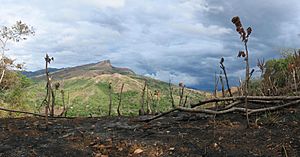
Losing or damaging their habitat is the main reason humans cause species to go extinct today. The biggest cause of habitat damage worldwide is farming. Other causes include building cities, cutting down forests, mining, and some fishing methods. When a species' habitat is damaged, it might not be able to find enough food, water, or shelter to survive.
Habitat damage can happen quickly, like when an area becomes toxic due to pollution, killing or harming all living things there. It can also happen slowly over time, making it harder for species to live, reproduce, or compete with others.
Sometimes, habitats are physically destroyed. For example, when tropical rainforests are cut down to make farmland, many species that need the dense forest to survive disappear. A fern that needs deep shade can't live if the forest is gone. Another example is when fishing methods like bottom trawling destroy the ocean floor.
Global warming also causes habitat changes. It allows some species to move into new areas, which can create unwelcome competition for species already living there. Sometimes, these new species are predators that hunt the native animals. Other times, they just compete for limited resources like water and food, making it harder for vulnerable species to survive.
Predators, Competition, and Diseases
In nature, species can go extinct for many reasons. These include losing a necessary host (like a plant a bug lives on), prey (food source), or pollinator (an animal that helps plants reproduce). They can also disappear due to competition with other species, new diseases, or sudden environmental changes that bring new predators or remove their food.
Humans have also become a major cause of extinction, often making species disappear much faster than they would naturally. We do this by being new "mega-predators" or by moving animals and plants around the world. This has happened for thousands of years, sometimes on purpose (like sailors leaving livestock on islands for food) and sometimes by accident (like rats escaping from boats). Most of the time, these new species don't survive in their new homes. But when an invasive alien species does get established, it can be very bad for native species. Invasive species can eat native animals, compete with them for food, or bring new diseases.
The "overkill hypothesis" suggests that when humans first arrived in places like Australia, North America, and South America, many large animals (megafauna) quickly went extinct. This was because these animals had never seen humans before and didn't know how to protect themselves from human hunting.
Coextinction
Coextinction means one species disappears because another species it depends on goes extinct. For example, if a plant goes extinct, the insects that only eat that plant might also disappear. Coextinction can also happen if a species loses its pollinator (like a bee that pollinates a specific flower) or if a predator loses its prey (food source).
Scientists say that coextinction shows how connected all living things are in an ecosystem. It's especially common when a keystone species (a species that plays a very important role in its ecosystem) goes extinct. A famous example is the Haast's eagle and the moa in New Zealand. The Haast's eagle was a huge predator that hunted moa, which were large flightless birds. When humans hunted the moa to extinction, the Haast's eagle lost its main food source and also became extinct.
Climate Change
Fossil studies have shown that climate change has caused extinctions in the past. For instance, many amphibians died out during the Carboniferous Rainforest Collapse 305 million years ago. A study in 2003 predicted that due to climate change, 15–37% of land species could be "committed to extinction" by 2050. Areas with lots of different species, like the Cape Floristic Region and the Caribbean Basin, might lose the most. These places could see rising temperatures and higher carbon dioxide levels, which might cause 56,000 plant and 3,700 animal species to disappear.
Mass Extinctions
Earth's history has seen at least five major mass extinctions. These are times when many species disappear in a relatively short period of geological time. About 250 million years ago, a huge volcanic eruption may have caused the "Permian–Triassic extinction event", which is thought to have killed off 90% of all species alive then. There's also evidence that another mass extinction, called Olson's Extinction, happened just before that. The Cretaceous–Paleogene extinction event (K-Pg) happened 66 million years ago. This event is famous for wiping out the non-avian dinosaurs, along with many other species.
Related Pages
Images for kids
-
The Tasmanian tiger (Thylacinus cynocephalus) is an example of an extinct species.
-
External mold of the extinct Lepidodendron from the Upper Carboniferous of Ohio
-
The dodo of Mauritius, shown here in a 1626 illustration by Roelant Savery, is an often-cited example of modern extinction.
-
The passenger pigeon, one of the hundreds of species of extinct birds, was hunted to extinction over the course of a few decades.
-
Tyrannosaurus, one of the many extinct dinosaur genera. The cause of the Cretaceous–Paleogene extinction event is a subject of much debate amongst researchers.
-
Georges Cuvier compared fossil mammoth jaws to those of living elephants, concluding that they were distinct from any known living species.
-
A great hammerhead caught by a sport fisherman. Human exploitation now threatens the survival of this species. Overfishing is the primary driver of shark population declines, which have fallen over 71% since 1970.
See also
 In Spanish: Extinción para niños
In Spanish: Extinción para niños


